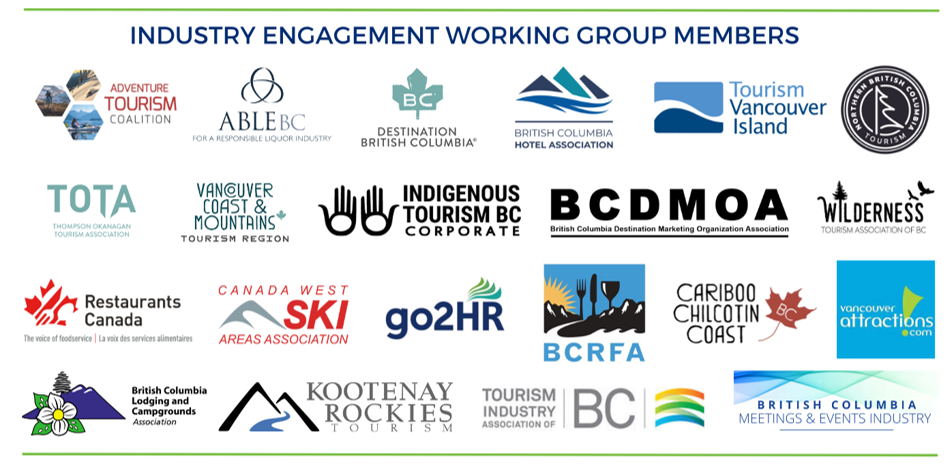Multi-cultural group of Tourism & Hospitality Workers.
BC’s Tourism & Hospitality Labour Recovery Framework
Tourism and hospitality labour recovery – and resiliency – is integral to B.C.’s long-term economic strategy. The Province’s Strategic Framework for Tourism recognizes the role our industry plays in community enhancement, sustainable growth, and climate action. The Province’s goal to rebuild our industry’s revenues by 2024 will, put simply, be powered by people.
People also power our Labour Recovery Framework. Since fall 2021, go2HR has led the Labour Recovery Framework Industry Engagement Working Group, a tight-knit team of industry leaders from associations, destination management organizations and provincial ministries.
Labour Recover Framework Report
Click the link below to get the comprehensive report outlining the Labour Recover Framework.
Labour Recover Framework Summary
Click the link below to get the summary outlining the Labour Recover Framework’s Six Pillars, their priorities and the initiatives being created.
Nature and cultural tour of the Butze Rapids Trail in Prince Rupert with the Gitmaxmak'ay Nisga'a Society.
Overview
Job one was building a single framework for labour recovery that, if implemented, could help build back the labour needed for our industry. The framework includes six prioritized pillars, each with a set of new initiatives. The framework is grounded in research and industry experience and aligned with provincial and federal priorities.
The Six Pillars of the Labour Recovery Framework:
- Grow Labour
- Renew Our Value
- Engage On Housing
- Build Back Stronger
- Future-Proof Skills Development
- Transform with Technology
With the framework built, we set out to artfully implement key initiatives. Arguably one of the GOAT, Pablo Picasso said that “action is the foundational key to all success.” We set out to do what we could with the capacity and resources we could find.
Restaurant Server in BC serving patrons.
Today, we have key partners in place that are supporting partial implementation of Pillars 1, 2 and 4.
Pillar 1 is focused on attracting, maintaining, and retaining people that work in tourism and hospitality. Pillar 2 is communicating the value of our industry as a place for people to work – and as a foundational contributor to B.C.’s economic strategy.
With funding from PacificEconomic Development Canada, we are launching a recruitment campaign targeted at key audiences we hope will join our industry in greater numbers – youth, newcomers, and Indigenous Peoples. This funding is also supporting the development of a career awareness project aimed at showcasing to high school students the wealth of career opportunities in tourism and hospitality.
Pillar 4 is focused on supporting employers to implement best-in-class business practices. With funding from the Ministry of Tourism, Arts, Culture and Sport, go2HR has established a network of HR consultants across the province. On the ground in each tourism economic region, consultants offer free human resources advisory services to support best practices in recruitment, retention, benefits, health and safety and employment legislation compliance.
Stay tuned as we continue our progress to implement our Labour Recovery Framework.
Download the ReportSix Pillars of the Labour Recovery Framework
Industry Engagement Working Group prioritized a set of new initiatives for each pillar – all require capacity and investment.
Initiative
1.1 Tourism of Tomorrow
1.2 Experience Tourism
1.3 Teaching Tourism Toolkit
1.4 Post-Secondary Pursuit
1.5 International Worker Access
1.6 Indigenous Inclusion
1.7 Newcomer Advocate
1.8 Opportunity For All
Initiative
2.1 Recalibrating Our Value To Workers
2.2 MultiModal Messaging
2.3 Research and Metrics That Matter
Initiative
3.1 Tourism & Hospitality Community Housing Liason
Initiative
4.1 Raise the HR Bar
4.2 Business Practice Pilot
Initiative
5.1 Skill Sustainer Advisor
5.2 Train @ Work in Tourism Grant
5.3 SuperHost® Starter
Initiative
6.1 Tech/Tourism Hub
6.2 Tech in Tourism Innovation Grant
Industry Partners
Experienced leaders formed an Industry Engagement Working Group to agree on areas of focus, with priorities and initiatives for each pillar
